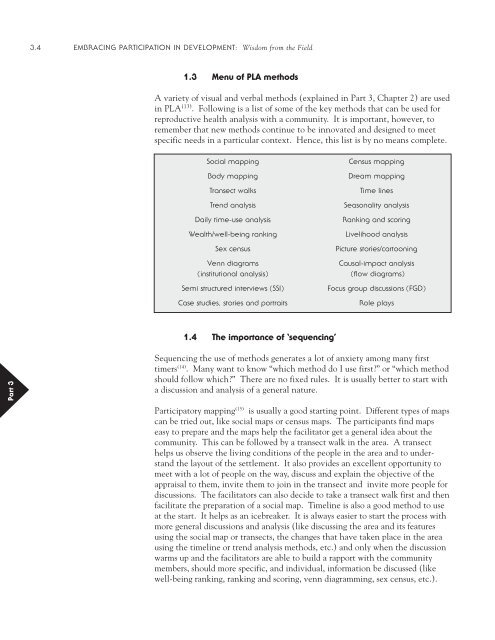PRA-Manual Embracing Participitation tools-only.pdf - PACA
PRA-Manual Embracing Participitation tools-only.pdf - PACA
PRA-Manual Embracing Participitation tools-only.pdf - PACA
Create successful ePaper yourself
Turn your PDF publications into a flip-book with our unique Google optimized e-Paper software.
3.4 EMBRACING PARTICIPATION IN DEVELOPMENT: Wisdom from the Field<br />
1.3 Menu of PLA methods<br />
A variety of visual and verbal methods (explained in Part 3, Chapter 2) are used<br />
in PLA (13) . Following is a list of some of the key methods that can be used for<br />
reproductive health analysis with a community. It is important, however, to<br />
remember that new methods continue to be innovated and designed to meet<br />
specific needs in a particular context. Hence, this list is by no means complete.<br />
Social mapping<br />
Body mapping<br />
Transect walks<br />
Trend analysis<br />
Daily time-use analysis<br />
Wealth/well-being ranking<br />
Sex census<br />
Venn diagrams<br />
(institutional analysis)<br />
Semi structured interviews (SSI)<br />
Case studies, stories and portraits<br />
Census mapping<br />
Dream mapping<br />
Time lines<br />
Seasonality analysis<br />
Ranking and scoring<br />
Livelihood analysis<br />
Picture stories/cartooning<br />
Causal-impact analysis<br />
(flow diagrams)<br />
Focus group discussions (FGD)<br />
Role plays<br />
1.4 The importance of ‘sequencing’<br />
Part 3<br />
Sequencing the use of methods generates a lot of anxiety among many first<br />
timers (14) . Many want to know “which method do I use first?” or “which method<br />
should follow which?” There are no fixed rules. It is usually better to start with<br />
a discussion and analysis of a general nature.<br />
Participatory mapping (15) is usually a good starting point. Different types of maps<br />
can be tried out, like social maps or census maps. The participants find maps<br />
easy to prepare and the maps help the facilitator get a general idea about the<br />
community. This can be followed by a transect walk in the area. A transect<br />
helps us observe the living conditions of the people in the area and to understand<br />
the layout of the settlement. It also provides an excellent opportunity to<br />
meet with a lot of people on the way, discuss and explain the objective of the<br />
appraisal to them, invite them to join in the transect and invite more people for<br />
discussions. The facilitators can also decide to take a transect walk first and then<br />
facilitate the preparation of a social map. Timeline is also a good method to use<br />
at the start. It helps as an icebreaker. It is always easier to start the process with<br />
more general discussions and analysis (like discussing the area and its features<br />
using the social map or transects, the changes that have taken place in the area<br />
using the timeline or trend analysis methods, etc.) and <strong>only</strong> when the discussion<br />
warms up and the facilitators are able to build a rapport with the community<br />
members, should more specific, and individual, information be discussed (like<br />
well-being ranking, ranking and scoring, venn diagramming, sex census, etc.).














